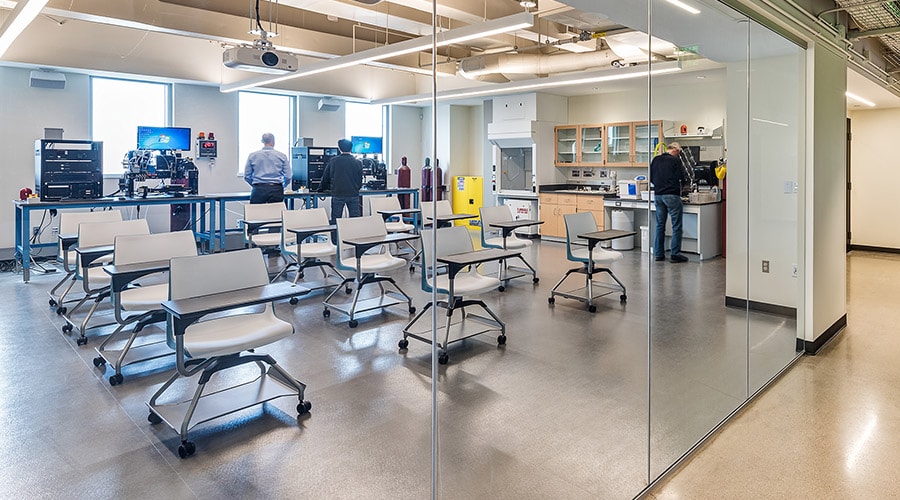How to Social Distance on Campus

Will the schools in your community be opening their doors again this fall? Education leaders all over the country are thinking long and hard about how to return to in-person learning safely.
At KI, we’ve put a lot of thought into that question, too. With that in mind, here are a few design tips from our team for facilitating a safe return to school.
Boundaries Are Key
Pre-pandemic, schools were chock full of high-fives, pats on the back and fist bumps. Thanks to the coronavirus, we all know those friendly interactions will have to be temporarily retired.
Teachers and administrators can use mobile dividers and screens to transform everything from classrooms and communal lounges to faculty and staff offices into spaces that support social distancing.
For example, students could raise Universal Height-Adjustable Screens attached to individual desks or library tables to prevent the spread of germs from neighbors -- or lower them to allow for more airflow if they’re alone in a room. Taller, freestanding Connection Zone Screens might be a good way to naturally delineate space within a classroom so students can study in smaller groups.
Screens and dividers both will prove useful even after the pandemic subsides. Universal Height-Adjustable Screens, for instance, serve as great acoustic and visual separators that help students focus during tests.
Campus Traffic Control
Dozens of school administrators nationwide have told us their top concern is the overall flow of foot traffic throughout campus, rather than the design of any particular space.
Public places like supermarkets have responded to the pandemic by putting fixtures in place to control traffic and minimize the chances of people bumping into each other. Schools can implement a similar strategy by installing mobile dividers and movable walls for wayfinding.
Our All Terrain Screens and Tattoo Flex Screens are versatile enough for school administrators to pair them with floor graphics to guide students through shared spaces like libraries, advisors’ offices and cafeterias.
Schools may also consider deploying movable glass architectural walls like Lightline to bisect busy thoroughfares so students can move safely while still seeing their peers outside the classroom.
A Modern-Day One-Room Schoolhouse
School administrators can put a new spin on the “one-room schoolhouse” concept by allowing students to remain in one classroom all day and having teachers move from room to room.
Mobile storage carts and lecterns from our Ruckus Collection enable that kind of movement while ensuring that teachers don’t have to share equipment. Ruckus also provides incredible value, with its industry-leading 15-year warranty.
Teachers may also consider swapping out communal tables for mobile desks or tablet arm chairs that they can reconfigure to support different lessons within one classroom. Doni or Strive stack chairs paired with the ChangeUp tablet arm permit students to flip up or fold down their worksurface as needed. After the pandemic, mobile furniture will continue to support student collaboration and active learning.
Stay Social Havens
From kindergarten through college, schools provide students an important social experience. They can still do so in the era of social distancing, albeit in smaller groups.
One college and university designer we interviewed about the return to school emphasized that students were willing to adapt if it meant they could learn together in person. “Our faculty and our students are incredibly excited to return to campus, even if that includes some restrictions and changed policies,” she said.
Our MyPlace Lounge Collection, which includes products with large footprints, curved seats and optional casters, is ideal for outlining spatial boundaries without compromising student interaction.
In the classroom, administrators may consider pairing mobile Learn2 Seating or Ruckus Chairs with carpet insets or floor graphics to ensure students practice social distancing while collaborating with their classmates.
There may be a silver lining to reducing the number of students in each classroom -- more individual attention for each student. One middle-school student told us that online learning hasn’t been conducive to one-on-one time. “I much prefer [being] in class because it’s so much easier to get support from teachers and it’s more balanced for me,” she said.
Safety Above All
We don’t know exactly what schools will look like when they re-open their doors. But we do know that safety will be a top priority for students, educators and families alike. Simple design changes can go a long way toward making classrooms and campuses more spatially friendly without compromising learning.
Subscribe
Stay up to date with the latest trends and more.









